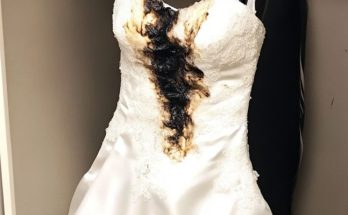When it comes to dress codes, especially in public places like stores or supermarkets, people have strong opinions. Recently, a Brazilian woman named Kerolay Chaves made headlines for claiming she was kicked out of a supermarket due to her choice of clothing. According to Chaves, her denim shorts, which she admits were extremely short, led to her being “harassed” and ultimately “expelled” from the store. However, what she called a case of “being bullied for being too hot” sparked a fierce debate online, with critics arguing that her outfit was inappropriate for a family-oriented setting. Here’s a breakdown of the controversy and the broader conversation it ignited around dress codes and personal freedom.

The Incident: Alleged Harassment and Expulsion Over Outfit
Kerolay Chaves, a social media influencer from Brazil, took to Instagram to share her story. She posted a photo of her outfit, which consisted of ultra-short denim shorts that many described as resembling underwear. In her post, she claimed that shoppers at the store had reacted negatively to her appearance, with some even resorting to name-calling and glares. She alleged that the supermarket’s staff ultimately asked her to leave, which she interpreted as an act of prejudice.
“I just got home from the supermarket and was harassed for wearing ‘too short clothes’,” Chaves wrote, expressing frustration at what she saw as unfair treatment. “Some people looked at me with prejudice, others cursed me and finally, I was expelled from the place.” Chaves added that she believed her experience reflected a deeper bias against attractive women who choose to dress boldly, arguing, “We go through this because we are too hot.”
Public Reaction: Support and Criticism
Chaves’ post quickly went viral, attracting mixed reactions. Some of her followers agreed with her, viewing the situation as an example of society’s tendency to shame women for their clothing choices. These supporters argued that she had every right to wear what she wanted and shouldn’t have faced such backlash. For them, her experience represented a broader issue of women being unfairly judged or sexualized simply for their appearance.
However, a significant number of people took the opposing stance. Critics of Chaves’ outfit argued that while personal freedom is important, there is a time and place for everything, and a supermarket may not be the best venue for such revealing clothing. One commenter wrote, “There’s no need to go to a supermarket dressed like that. You are embarrassing the decent people who are often there with children.” Another person pointed out that a shirtless man would likely face similar consequences, implying that the issue was about appropriateness rather than gender bias.
Skepticism and Accusations of “Engagement Stunt”
Beyond the debate over dress codes, some social media users questioned the authenticity of Chaves’ story. Several commenters accused her of using the incident as a way to gain attention and engagement on social media. One critic noted, “Clearly it was for engagement and Instagram likes. She never went to the supermarket like this. Those who follow the stories know.”
Others pointed to details in her Instagram post that raised suspicions. For instance, some users observed a piece of clothing inside Chaves’ shopping cart, suggesting that she might have removed an outer layer only to take photos for social media. One person commented, “There’s a piece of clothing inside the cart… I don’t think she entered the market like that… maybe she had covered the bottom part and took it off just to take those pictures… I guess she didn’t get kicked out of anything.”

The Ongoing Debate on Dress Codes and Public Spaces
The incident sparked a broader conversation about dress codes in public spaces. While private establishments have the right to enforce dress standards, society is increasingly divided over what constitutes “appropriate” attire. Many argue that dress codes are outdated or used to shame individuals—particularly women—who don’t conform to conservative standards. Others believe dress codes are necessary to maintain a family-friendly environment, especially in spaces frequented by children.
In recent years, controversies around dress codes have become more common, as social media has amplified personal stories and the resulting debates. For some, being asked to leave a public space over clothing feels like an attack on personal freedom and self-expression. Others, however, view dress codes as a way to respect the comfort levels of all patrons.

Women’s Right to Self-Expression vs. Public Sensitivity
This incident touches on a larger issue: the balance between individual rights and public comfort. Many argue that people should have the freedom to dress in a way that expresses their identity and boosts their confidence. For women, this often means challenging traditional norms, particularly around what is deemed “appropriate.”
Chaves clearly believes her experience was a form of prejudice rooted in jealousy or discomfort with her appearance. Her supporters view this incident as yet another example of how women are scrutinized and policed for their clothing choices, especially when they don’t conform to conventional standards.
On the other hand, some believe that social spaces like supermarkets require a degree of decorum and respect for others, particularly for families and children. They argue that freedom of expression must sometimes be balanced with a responsibility to respect communal spaces, where revealing outfits might be deemed distracting or inappropriate.

Is Social Media Amplifying Controversy for Attention?
There’s also the question of whether social media incentivizes these types of incidents. As some commenters pointed out, publicizing such experiences can drive engagement and grow an influencer’s following. By sharing controversial or boundary-pushing stories, influencers can attract more likes, comments, and followers. For some, this calls into question the sincerity of these “scandals” and whether they are exaggerated or even manufactured to gain attention.
In Chaves’ case, her story went viral, increasing her visibility online and sparking widespread debate. While she may have felt genuinely harassed, some argue that social media has turned every minor conflict into an opportunity for engagement, creating a culture where personal grievances are amplified for likes.
The Complex Landscape of Modern Modesty and Freedom
Ultimately, the debate over Chaves’ supermarket experience highlights the complexities of modern dress codes, modesty, and freedom of expression. In today’s world, where social norms are increasingly challenged and individualism is celebrated, determining what’s appropriate for public spaces isn’t as clear-cut as it used to be. Opinions on dress and appearance vary widely, shaped by personal beliefs, cultural values, and generational differences.
As our society continues to evolve, so too will our standards of dress. Whether or not Chaves’ incident was a genuine example of prejudice or a ploy for social media fame, it’s clear that conversations around clothing, body image, and social judgment are far from over.
Conclusion: A Question of Balance
Kerolay Chaves’ story may have started as a debate over a pair of shorts, but it touches on deeper issues of personal freedom, societal standards, and the influence of social media. As we navigate the balance between self-expression and respect for communal spaces, incidents like these will likely continue to spark discussion. Whether you believe Chaves’ experience was justified or view it as a publicity stunt, it’s a reminder that how we dress—and how others perceive it—remains a powerful and often polarizing topic.



